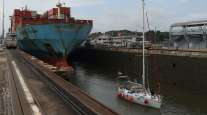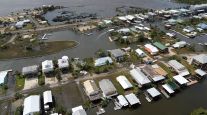Staff Reporter
Port Tampa Bay Finishes Deepening, Hopes for More Cargo
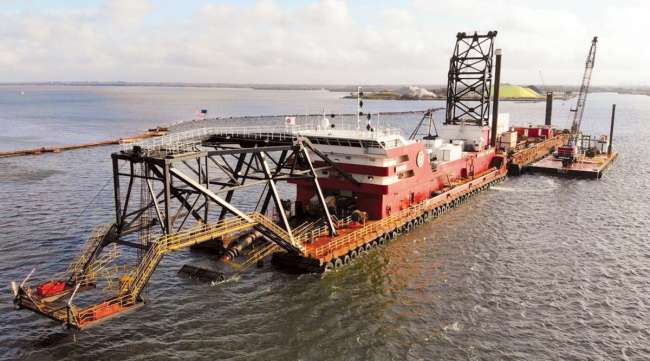
[Stay on top of transportation news: Get TTNews in your inbox.]
Port Tampa Bay completed a $63 million expansion of its Big Bend Channel a year ahead of schedule, port officials said, as the Sunshine State eyes grabbing more freight from shippers while serving a growing distribution corridor in Central Florida.
The expansion deepened and widened the channel, allowing for larger ships to call at the terminals, according to a Port Tampa Bay news release. The project deepened Big Bend to 43 feet from 34 and widened the entrance channel to 250 feet from 200 feet for a length of 1.9 miles, according to the release.
The Sunshine State has 15 commercial seaports, but only Tampa is directly linked to Interstate 4, a west-to-east corridor seen as key to Central Florida’s growth. The access to I-4 is so important, the Florida Department of Transportation partnered with the port to build a truck-only ramp from the facility to the interstate, according to Florida Ports Council CEO Doug Wheeler.
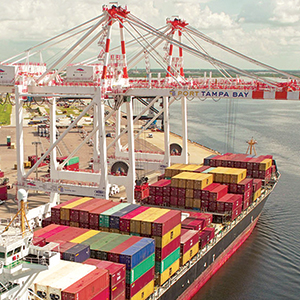
Out of 15 commercial seaports in Florida, only Tampa's is directly linked to Interstate 4. (Port of Tampa Bay)
In fiscal 2018, Tampa Bay saw its container traffic jump by 60.7% to 90,000 industry-standard 20-foot-equivalent units from 56,000, Wheeler said. Tampa Bay, the state’s largest port in terms of land, handles a lot of aggregate cargo, such as limestone, sugar, salt and fertilizer, according to Wheeler.
The Big Bend Channel expansion was funded by the U.S. Army Corps of Engineers, the Florida Department of Transportation, Port Tampa Bay and two of the largest port users, The Mosaic Co. and Tampa Electric, according to port officials. The Mosaic Co. is a producer and marketer of concentrated phosphate and potash, used for crops.
The channel serves Port Redwing, 270 acres of Port Tampa Bay property in southern Hillsborough County. The area is expected to develop into a major hub for warehousing and distribution within the next decade, according to port spokeswoman Samara Sodos.
In February, Colliers International, a national commercial real estate firm, ranked the corridor as one of the top 10 emerging industrial markets in the United States.
“This corridor is the heartbeat of industrial distribution throughout the state of Florida,” Richard Davis, Colliers’ executive managing director for Florida, wrote in the Colliers report. “Along the I-4 corridor, users such as Amazon, Walmart, PepsiCo, BestBuy, Lowe’s and many more have the ability to reach a population in excess of 14 million people within four hours. Because of this, we have seen the prevalence of speculative development significantly increase in the past three years, and we foresee this trend continuing.”
Wheeler said Florida can handle the cargo that will be coming through the expanded Panama Canal, completed in 2016, with its larger ships making their way from Asia to the East Coast.
He notes Miami’s port has been 50 feet deep for four years, which allows it to take the larger ships the Panama Canal is sending.
“There really isn’t a cargo we can’t handle,” Wheeler told Transport Topics. “Florida needs to capture cargo.”
The Florida Ports Council reports the state’s largest ports, in terms of TEUs handled in fiscal 2018, are Jacksonville, which moved 1.4 million TEUs; Port Everglades in Fort Lauderdale, which handled 1.1 million; Miami, which handled 1,083,000; and the Port of Palm Beach, which handled 290,000.
Last year, the state handled $87.3 billion in waterborne international trade; $54.2 billion was in imports and $33.1 billion was in exports, the council reported. Containerized cargo vessels carried $57.4 billion in trade to and from Florida, up 5.5% over the prior year.
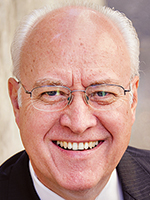
Armstrong
“Every Florida port is bursting at the seams,” Florida Trucking Association CEO Ken Armstrong said. “Under Gov. Rick Scott [the governor from 2011 to 2019], we made unprecedented improvements. We were seeing money just pouring into the ports for improvements.”
Wheeler said Tampa Bay’s upgrades come as cargo and freight traffic to and from foreign sources surge.
“We are seeing growth,” he said. “What we are seeing are benefits from investments made in the ports.”
Wheeler concedes Florida was a “little late” in responding to growing containerships making their way through the bigger Panama Canal. The ships have grown even larger since the expansion, and many bypass Florida for bigger East Coast ports. Savannah, Ga., alone handled 4.35 million TEUs in 2018, according to the Georgia Ports Authority website.
And in July, Miami port Director Juan Kuryla told the Miami Herald that his port was deep enough for the growing container superships but not wide enough for some newer ships. The port is undergoing a feasibility study to look at widening its channels.
The challenges stand, but Armstrong said Florida seems ready to compete.
“It’s a pretty good picture down here right now,”he said.



